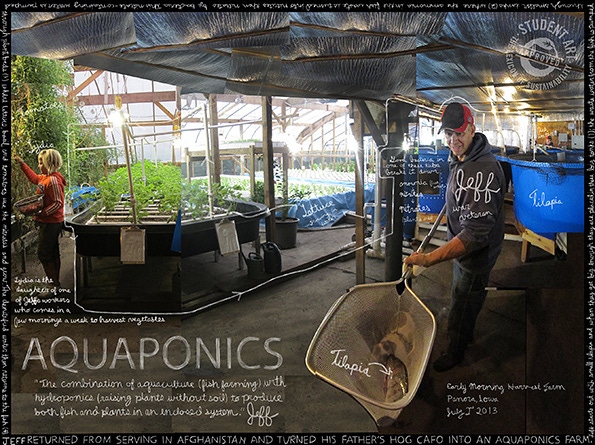Watchword: Aquaculture/Mariculture
To draw attention to the best and brightest ideas in sustainability, the Lexicon of Sustainability's Food List project defines the words that are integral to a healthy, transparent, and accountable food system. Each week, we explore a new word through artwork, films, recipes, and written works.See all Food List words here.
December 10, 2014

“Seafood’s going to be the only viable way to have protein by 2050. Even if we remove all the forests from the planet and plant them as agricultural crops, we still couldn’t sustain nine billion people. So seafood, whether it’s wild-capture or aquaculture, is going to play a big part in feeding the world’s population.”
—Thomas Kraft, founder of Norpac Fisheries Export
The significance of fishermen is often overlooked, but they play a crucial role as ambassadors to the sea. To create a future without food scarcity and environmental plunder, our critical challenge is to find new ways to produce more fish without causing more harm.
Fish farms are either land-based (aquaculture) or ocean-based (mariculture). Each has its own perks and challenges. Forward-thinking fish farmers, other entrepreneurs, and scientists are already working on exemplary systems and practices to raise fish without negative impacts.

Title: Aquaponics
Featuring: Jeff Hafner and Lydia, a daughter of one of the farmers
Location: Early Morning Harvest Farm in Panora, Iowa
Aquaponics is the combination of aquaculture (fish farming) with hydroponics (raising plants without soil) to produce both fish and plants in an enclosed system.
Jeff Hafner (pictured above) returned from serving in Afghanistan and, with his father, turned a hog CAFO into an aquaponics farm. Jeff starts out with small tilapia and when they are big enough they are placed in the big tanks. The waste water from the fish is pumped through smaller tanks where the ammonium in the fish waste is turned into nitrates containing water is punched through plant beds where lettuce, basil and tomatoes use the nutrients and grow. The denitrified water then goes back to the fish.
Short film: "Future Fish" by The Perennial Plate
Veta La Palma is a fish farm that takes “sustainable” to a whole new level. Inspired by Dan Barber’s TED talk on the subject, we made the trek out one windy afternoon to the flooded wetlands of Southern Spain to learn about this alternative approach to growing fish.
Sustainable heroes: Marianne Cufone, Executive Director of the Recirculating Farms Coalition
 Recirculating farms can sustainably grow fish, vegetables, flowers, fruits, herbs and more, in a mostly self-contained, closed system. Considering the issues that plague our industrial food systems, a stable, safe and flexible means of food production is just what our country needs.
Recirculating farms can sustainably grow fish, vegetables, flowers, fruits, herbs and more, in a mostly self-contained, closed system. Considering the issues that plague our industrial food systems, a stable, safe and flexible means of food production is just what our country needs.
Marianne Cufone established the Recirculating Farms Coalition in New Orleans, Louisiana with the goal of creating a model aquaculture farm to demonstrate how easily and effectively recirculating aquaculture can be accomplished. The Coalition is a collaborative group of farmers, educators, non-profit organizations and many others committed to building local sources of healthy, accessible food. Through research, education and advocacy, the coalition works together to support the development of energy efficient farms that use clean, recycled water to grow food. The farms can create stable, green jobs in diverse communities nationwide, and someday, worldwide.
Check out this great interview with Marianne over at Ecocentric.
For the past three years, the Lexicon of Sustainability has sought out the foremost practitioners of sustainability in food and farming to gain their insights and experiences on this important subject. What began as a photography project to spread their knowledge has grown to include short films, study guides, traveling shows, a book, and a website where people can add their own terms to this ever-evolving lexicon. See more at www.lexiconofsustainability.com.
About the Author(s)
You May Also Like




